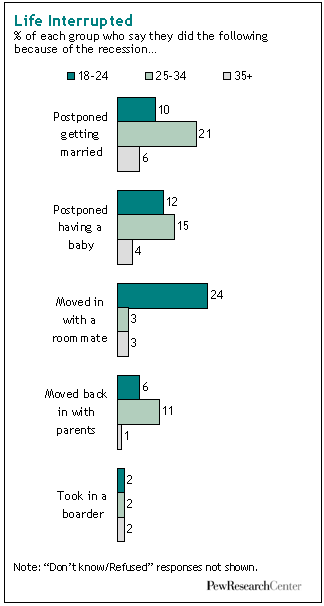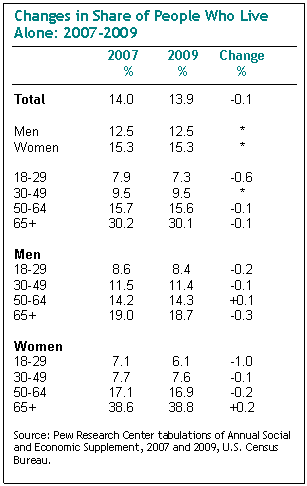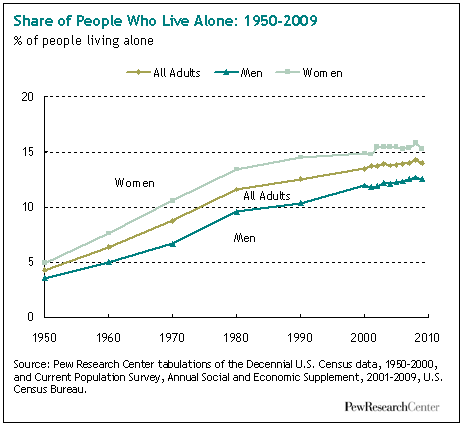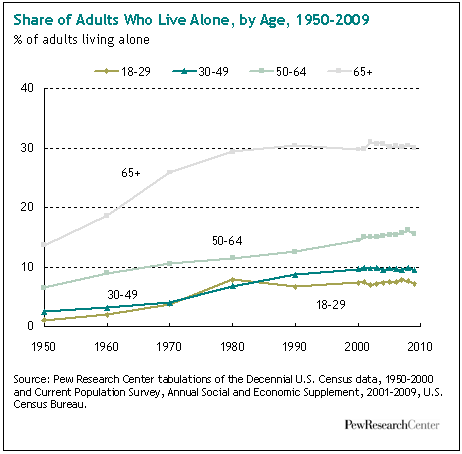The journey home for Thanksgiving won’t be quite so far this year for many young adults. Instead of traveling across country or across town, many grown sons and daughters will be coming to dinner from their old bedroom down the hall, which now doubles as their recession-era refuge.
A recent survey by the Pew Research Center finds that 13% of parents with grown children say one of their adult sons or daughters has moved back home in the past year. Social scientists call them “boomerangers” — young adults who move in with parents after living away from home. This recession has produced a bumper crop.

Census Bureau data confirm that proportionately fewer young adults are living solo now than before the recession. Overall, the proportion of adults ages 18 to 29 who live alone declined from 7.9% in 2007 to 7.3% in 2009. Similar drops in the proportion of young people who live by themselves occurred during or immediately after the recessions of 1982 and 2001.
The current decline has been particularly steep among young women; the proportion who live by themselves fell by a full percentage point to 6.1%. Among young men, the share living on their own fell 0.2 percentage points to 8.4%, a statistically insignificant change.
While the recession has touched Americans of all ages, it has been particularly hard on young adults. According to the Bureau of Labor Statistics, a smaller share of 16- to 24-year-olds are currently employed — 46.1% — than at any time since the government began collecting such data in 1948.
At the same time, college enrollment has soared to an all-time high. Taken together, record unemployment and growing college enrollments help explain why proportionately fewer young people today are living by themselves.

The Pew Research Center survey also asked all respondents if they had moved back home because of the recession. Fully one-in-ten adults ages 18 to 34 (10%) say the poor economy has forced them to move back in with Mom and Dad.1 An additional 12% say they acquired a roommate. Hard times are leading young adults to put their lives on hold in other ways as well. For example, some 15% of adults younger than 35 say they have postponed getting married because of the recession; an additional 14% say they have delayed having a baby.
Data from two different but complementary sources are used in this analysis to estimate the impact of the recession on living arrangements and family formation. The Annual Social and Economic Supplement to the Current Population Survey, conducted each March by the Census Bureau, was used to estimate the proportion of adults who lived alone in 2007 and in 2009. (The recession officially began in December 2007.)
These data are supplemented by a nationally representative survey of 1,028 adults by the Pew Research Center conducted Oct. 21-25, 2009. Results from this survey are used to produce estimates of changes in living arrangements and other actions taken by individuals in response to the recession.
Moving Back

To measure changes in household arrangements, the Pew Research survey asked all adults if they lived in their own home or with one or both parents in the parents’ home. The survey further asked all adults if they had moved back in with their parents “as a result of the recession.” Overall, about 11% of all adults 18 or older live with their parents in their home and 4% of all adults say they were forced to move back with their parents because of the recession, a proportion that rises to 10% among those ages 18 to 34.
About seven-in-ten grown children who live with their parents are younger than 30. About half work full- or part-time, while a quarter are unemployed and two-in-ten are full-time students. Of all adults who report they currently live in their parents’ home, about a third (35%) say they had lived independently at some point in their lives before returning home. While the sample is small, roughly equal proportions of adult men and women live with their parents, while a somewhat larger proportion of Hispanics and blacks than whites live with their parents.
When the focus shifts to parents, a similar story emerges. According to the survey, nearly half of all adults (46%) have children ages 18 or older. Among these parents of adult children, some 13% say at least one of their grown sons or daughters had returned home in the past year for any reason.
The proportion of “boomeranged parents” increases to 19% among those ages 45 to 54 and declines sharply in later age groups.
Putting Life on Hold
The survey also found that the recession has altered the lives of young adults in several other important ways. For example, fully 15% of single adults younger than 35 say they have postponed getting married because of the recession, while an additional 14% of all young adults delayed having a baby.2
The proportion of those who postponed their wedding because of the recession increases to 21% if the sample of young adults is limited to those 25 to 34 — the age range in which most people get married.
At the same time, the bad economy has sent many of the youngest adults in the sample — those ages 18 to 24 — scurrying to find a roommate. About one-in-four in that age group say they have moved in with a roommate because of the recession, eight times the proportion of 25- to 34-year-olds who have taken a similar step (24% vs. 3%).
But young adults are not the only ones whose lives have been changed by economic hard times. For example, about one-in-eight (12%) of all single adults between the ages of 35 and 54 have delayed marriage because of the recession.
At the same time, few Americans of any age have been forced by hard times to take in a boarder (2%) of all adults) or postpone a divorce (1% among married respondents).
Fewer Young Adults Are Living Alone

In a departure from an upward trend over many decades, the share of adults in the United States who live by themselves was largely unchanged between March 2007 and March 2009. However, the story is quite different for adults ages 18 to 29.
About 7.3% of young adults lived by themselves in March 2009, a 0.6 percentage point decline from 2007. Similar declines occurred during or after the recessions of 1982 and 2001; in both periods the proportion of adults 18 to 29 who lived alone fell by 0.5 points.
In particular, young women are less likely to be living alone in 2009 than in 2007. According to the Census Bureau, the share of young women living alone has declined from 7.1% in 2007 to 6.1% this year. The drop in the share of young men who live by themselves was a statistically insignificant 0.2 percentage points.
Among adults of all ages, the percentage living alone fell during this period by 0.1 points to 13.9%. If the calculation is based on households rather than individuals, individuals living alone currently make up slightly more than a quarter of all American households (27%).
Trends in Living Alone
The proportion of Americans who live alone has risen more or less st eadily since 1950, with the most rapid growth occurring roughly between 1950 and 1980.
According to the Census Bureau, less than 5% of the population lived by themselves in 1950. By 2000 this share had climbed to more than 13%, and it reached its historic high of 14.3% in 2008. Most recently, there has been a slight drop in the overall share of adults living alone. While the proportion is largely unchanged from two years ago, it did drop 0.4 percentage points in the past year.
Although this change may seem trivial, year-by-year CPS data collected since the 1970s suggest that a decline of 0.4 percentage points is rare. It only happened twice in more than three decades: once between 1982 and 1983, when the live-alone percentage dropped to 11.5% from 11.8% in 1982, and again in 1992 to 1993 when it also fell 0.4 percentage points. Notably, both periods were during or immediately after a recession.
The Demographics of Adults Who Live Alone
Women are more likely than men to live by themselves. Currently 15.3% of women and 12.5% of men live alone. The gap between the genders has expanded and narrowed over the years, with the smallest gap of 1.4 percentage points occurring in 1950 and the peak of 4.1 points recorded in 1990. Since 2000, the difference has stayed around 3 percentage points.
Living alone is closely related to age. In general, the older you get, the more likely you will live by yourself. Trends in the share of adults who live alone suggest a steady growth for all age groups since 1950, although the patterns are somewhat different for each group.

Only 1% of young adults ages 18 to 29 lived by themselves in 1950. That proportion increased rapidly to 7.5% by 1980 but then declined and has remained around 7.0% since 1990. In fact, the proportion of young adults living by themselves in 1980 was larger than it was for the 30-49 age group (7.5% vs. 6.5%). Today, the opposite is true, with those ages 30 to 49 more likely to be living alone than younger adults (9.5% vs. 7.3%).
Adults ages 65 and older are the most likely of any age group to be living alone. For this older group, the percentage of people who live alone sharply increased from 1950 to 1980 (13.7% to 29.4%) before leveling off. It now stands at 30.1%.

In particular, women ages 65 and older are much more likely than men of similar age to live alone, in large part because wives tend to outlive husbands, leaving more widows than widowers. Currently, nearly four-in-ten older women live by themselves; that’s more than double the proportion of older men (38.8% vs. 18.7%).
Among those younger than 50, the opposite pattern occurs. In this age group, the percentage of men who live alone outpaces the share of women. For example, 11.4% of men ages 30 to 49 live by themselves, compared with 7.6% of women.
About the Survey
Results for this survey are based on telephone interviews conducted with a nationally representative sample of 1,028 respondents ages 18 and older living in the continental United States. A combination of landline and cellular random digit dial (RDD) samples was used to represent all adults in the continental United States who have access to either a landline or cellular telephone. A total of 877 interviews were completed with respondents contacted by landline telephone and 151 with those contacted on their cellular phone. The data are weighted to produce a final sample that is representative of the general population of adults in the continental United States.
- Interviews conducted Oct. 21-25, 2009
- 1,028 interviews
- Margin of sampling error is plus or minus 3.9 percentage points for results based on the total sample at the 95% confidence level.
- Survey interviews were conducted under the direction of SSRS/Social Science Research Solutions. Interviews were conducted in English or Spanish.
*Paul Taylor, director of Pew Research Center’s Social & Demographic Trends project, edited the report. Senior writer D’Vera Cohn provided editorial suggestions and Marcia Kramer copy-edited the report.




